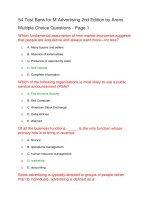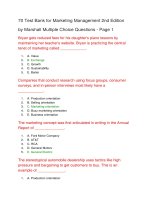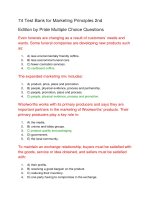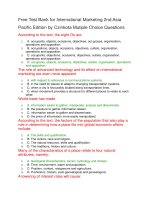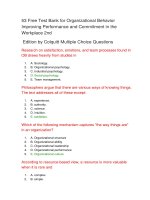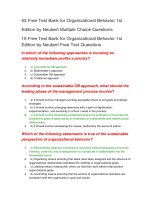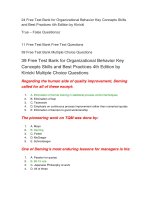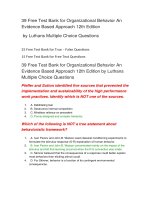90 test bank for organizational behaviour 2nd
Bạn đang xem bản rút gọn của tài liệu. Xem và tải ngay bản đầy đủ của tài liệu tại đây (127.04 KB, 22 trang )
Test Bank for Organizational Behaviour 2nd
27 Test Bank f True – False Questions
4 Test Bank Free Text Questions
59 Test Bank Multiple Choice Questions
The Rule of One-Eighth suggests that about 88 percent of the companies
will actually do what is required to build profits by putting people first.
1.
True
2.
False
Big decisions can be copied; they are visible to competitors and
observable by industry experts and analysts.
1.
True
2.
False
The integrative model of OB was designed with the Rule of One-Eighth in
mind.
1.
True
2.
False
Since good people create history and socially complex resources, they
are easy to imitate.
1.
True
2.
False
Meta-analysis offers more compelling support for the potential benefits of
social recognition than the methods of experience, intuition, or authority
could have provided.
1.
True
2.
False
People create history - a collective pool of experience, wisdom, and
knowledge that benefits the organization.
1.
True
2.
False
Firms that invest in organizational behaviour, typically have higher
survival rates.
1.
True
2.
False
The integrative model of OB in the text presents five individual
mechanisms that directly affect the individual outcomes: motivation;
learning and decision making; job performance; stress; and trust, justice,
and ethics.
1.
True
2.
False
Personality, cultural values, and ability reflect the various traits and
tendencies that describe how people act.
1.
True
2.
False
Personality and cultural values are two factors that reflect the
characteristics of individual employees.
1.
True
2.
False
Resources like culture, teamwork, trust, and reputation are termed
"socially complex" because it is not always clear which organizations do
(and do not) possess them, though it is clear how they came to develop.
1.
True
2.
False
Scientific methods begin with hypotheses and require that these be used
to inspire theories.
1.
True
2.
False
Firms that do not undergo an IPO typically have shorter histories and
need an infusion of cash to grow or introduce some new technology.
1.
True
2.
False
Human resource management focuses on the product choices and
industry characteristics that affect an organization's profitability.
1.
True
2.
False
Understanding correlation is important because OB questions are not
"yes or no" in nature.
1.
True
2.
False
The integrative model acknowledges that employees work in one or more
work teams led by some formal leader.
1.
True
2.
False
Hypotheses takes all the correlations found in studies of a particular
relationship and calculates a weighted average.
1.
True
2.
False
Teams, diversity and communication play an important role in achieving
the primary outcomes of job performance and organizational
commitment.
1.
True
2.
False
The resource-based view suggests that a resource is more valuable when
it can be imitated.
1.
True
2.
False
If people hold firmly to some belief because scientific studies have tended
to replicate results using a series of samples, settings, and methods, then
they are using their intuition.
1.
True
2.
False
The best way to get a feel for the correlation between two variables is to
look at a scatter plot—a graph made from those two columns of numbers.
1.
True
2.
False
The theories and concepts found in OB are actually drawn from two
disciplines: human resources management and strategic management.
1.
True
2.
False
Group mechanisms shape satisfaction, stress, motivation, trust, and
learning.
1.
True
2.
False
According to research conducted using the prospectus of IPO companies,
firms who valued OB had a 19 percent higher survival rate than firms who
did not value OB.
1.
True
2.
False
If people hold firmly to some belief because it seems obvious or selfevident, they are using their intuition.
1.
True
2.
False
It is often easy to "fix" companies that struggle with OB issues.
1.
True
2.
False
The best way to get a feel for the correlation between two variables is to
look at a scatterplot—a graph made from those two columns of numbers.
1.
True
2.
False
59 Free Test Bank for Organizational Behaviour 2nd
Canadian Edition by Colquitt Multiple Choice
Questions - Page 1
An OB study might explore the relationship between pay and motivation,
whereas a _______ study might examine the best way to structure
compensation programs.
1.
strategic management
2.
anthropology
3.
organizational development
4.
economics
5.
human resource management
OB research on job performance and individual characteristics draws
primarily from studies in
1.
industrial and organizational psychology
2.
economics
3.
strategic management
4.
sociology
5.
marketing
Which of these mechanisms dictates how the units within the firm link to
other units?
1.
organizational culture
2.
organizational ability
3.
job performance
4.
organizational structure
5.
organizational leadership
The primary outcomes of interest to organizational behaviour researchers
are:
1.
job performance and organizational commitment
2.
organizational culture and organizational structure
3.
team processes and team characteristics
4.
personality and ability
5.
stress and motivation
According to the survey of executives of 968 publicly held firms, the
results revealed that a one-unit increase in the proportion of the workforce
involved in the high performance work practices was associated with
which of these?
1.
An approximately 37 percent increase in turnover
2.
$627,000 more in sales per employee
3.
$918,000 more in market value
4.
$3,800 more in profits
5.
$1,638 more in employee bonuses
According to the survey of executives of 968 publicly held firms, the
results revealed that a one-unit increase in the proportion of the workforce
involved in the high performance work practices was associated with all
of these except:
1.
an approximately 7 percent decrease in turnover
2.
$27,000 more in sales per employee
3.
$18,000 more in market value
4.
$3,800 more in profits
5.
$638 more in employee bonuses
Which of these individual mechanisms captures the energetic forces that
drive employees' work efforts?
1.
motivation
2.
ability
3.
job performance
4.
personality
5.
stress
Which of these individual mechanisms reflects employees' psychological
responses to job demand that tax or exceed their capacities?
1.
job satisfaction
2.
ability
3.
job performance
4.
leadership style
5.
stress
According to the Rule of One-Eighth,
1.
At least 88 percent of organizations will do everything necessary to put people first
and thereby build profits
2.
At best 12 percent of organizations will actually do what is required to build profits
by putting people first
3.
75 percent of organizations won't believe the connection between how they
manage their people and the profits they earn
4.
38 percent of the organizations try to make a single change to solve their
problems
5.
One in eight organizations miserably fail at making the people to profit connection
Research on satisfaction, emotions, and team processes found in OB
draws heavily from studies in
1.
sociology
2.
economics
3.
strategic management
4.
social psychology
5.
marketing
Which of these takes the theories and principles studied in OB and
explores the "nuts-and-bolts" applications of those principles in
organizations?
1.
Human resource management
2.
Economics
3.
Social psychology
4.
Sociology
5.
Strategic management
What Suzie feels when thinking about her job and doing her day-to-day
work is captured in her
1.
ability
2.
job satisfaction
3.
personality
4.
organizational culture
5.
leadership style
A resource is more valuable if it is:
1.
rare
2.
imitable
3.
transparent
4.
simple
5.
all of the answers
All of these are individual mechanisms as reflected in the integrative
model of organizational behaviour except:
1.
stress
2.
motivation
3.
job satisfaction
4.
learning
5.
job performance
According to the integrative model of organizational behaviour, the two
types of group-level variables that impact individual-level attitudes and
behaviours are:
1.
job performance and organizational commitment
2.
learning and decision making
3.
leadership and teams
4.
personality and ability
5.
stress and motivation
Which of these mechanisms captures shared knowledge about the rules,
norms, and values that shape employee attitudes and behaviours?
1.
organizational structure
2.
organizational ability
3.
organizational culture
4.
job performance
5.
organizational leadership
According to the integrative model of organizational behaviour, the two
organizational-level variables that impact individual-level attitudes and
behaviours are:
1.
job performance and organizational commitment
2.
culture and structure
3.
team processes and team characteristics
4.
personality and ability
5.
stress and motivation
Personal attributes such as _______ influence how we behave at work and
the kinds of tasks that interest us.
1.
Leadership, stress, and job performance
2.
Stress, cultural values, and job performance
3.
Job performance, organizational structure, and ability
4.
Personality, cultural values, and ability
5.
Organizational structure, cultural values, and ability
Models from _______ are used to understand motivation, learning, and
decision making in OB.
1.
marketing
2.
economics
3.
sociology
4.
strategic management
5.
anthropology
American Drinks International is a soft drink manufacturer in the
carbonated soda industry. The firm is commissioning a study to explore
how the company's expansion into the new product segment of tropical
fruit flavored soda would affect its profitability. Such a study is addressed
in which of these areas?
1.
industrial and organizational psychology
2.
human resource management
3.
strategic management
4.
social psychology
5.
organizational behaviour
_______ is a field of study devoted to understanding, explaining, and
ultimately improving the attitudes and behaviours of individuals and
groups in organizations.
1.
Sociology
2.
Organizational behaviour
3.
Strategic management
4.
Social psychology
5.
Economics
People are inimitable for all of the following reasons except:
1.
they create a history
2.
they purchase new technology
3.
they make numerous small decisions
4.
they create socially complex resources
5.
unfortunately, people are not inimitable
Which course focuses on the product choices and industry
characteristics that affect the organization's profitability?
1.
organizational behaviour
2.
economics
3.
social psychology
4.
strategic management
5.
human resource management
According to the study focused on initial public offerings, firms who
valued OB had a _______ percent higher survival rate than firms who did
not value OB.
1.
71
2.
19
3.
47
4.
50
5.
3
The integrative model of organizational behaviour includes a number of
individual mechanisms that directly impact job performance and
organizational commitment. Those mechanisms include:
1.
leader styles and behaviour
2.
organizational culture and organizational structure
3.
team processes and team characteristics
4.
personality and ability
5.
stress and motivation
In exploring the importance of OB to company performance, the survey of
executives of 968 publicly held firms included of all of these outcomes
except:
1.
turnover
2.
productivity
3.
firm survival
4.
profitability
5.
market value
According to the integrative model of organizational behaviour, two of the
individual characteristics that impact individual attitudes and behaviours
include:
1.
job performance and organizational commitment
2.
organizational culture and organizational structure
3.
team processes and team characteristics
4.
personality and ability
5.
stress and motivation
According to the integrative model of organizational behaviour, which of
these is an individual outcome?
1.
job satisfaction
2.
ability
3.
job performance
4.
personality
5.
motivation
59 Free Test Bank for Organizational Behaviour 2nd
Canadian Edition by Colquitt Multiple Choice
Questions - Page 2
Scientific studies are based on the scientific method originated by Sir
1.
Jeffery Pfeffer
2.
Frederick Taylor
3.
Charles Darwin
4.
Francis Bacon
5.
Robert Hogan
_______ are written predictions that specify relations between variables.
1.
hypotheses
2.
verifications
3.
theories
4.
data
5.
construct
Which concept captures the idea that people make many small decisions
day in and day out, week in and week out?
1.
Numerous small decisions
2.
Resource-based view
3.
Meta-analysis
4.
Rule of one-eighth
5.
Socially complex resources
In organizational behaviour research, a correlation of .10 is considered:
1.
weak
2.
strong
3.
moderate
4.
useless
5.
perfect
Which of these takes all the correlations found in studies of a particular
relationship and calculates a weighted average of them?
1.
human resource management
2.
resource-based view
3.
meta-analysis
4.
strategic management
5.
method of intuition
Which of the following deals with how employees gain job knowledge and
how they use that knowledge to make accurate judgments on the job?
1.
Team processes
2.
Trust, justice, and ethics
3.
Learning and decision making
4.
Personality and ability
5.
Motivation
_____ research is vital to research on team characteristics and
organizational structure.
1.
Social psychology
2.
Industrial and organizational psychology
3.
Anthropology
4.
Economics
5.
Sociology
A meta-analysis conducted on the effects of social recognition and job
performance across studies conducted in 96 different organizations in the
service industry indicates an average correlation of _______.
1.
0.66
2.
0.50
3.
0.35
4.
0.21
5.
0.03
Which of the following affects the way people behave at work, the kinds of
tasks they are interested in, and how they react to events that happen on
the job?
1.
Ability
2.
Trust, justice, and ethics
3.
Learning and decision making
4.
Team characteristics
5.
Personality and cultural values
_______ summarize the statistical relationships between variables.
1.
data
2.
correlations
3.
observations
4.
collections
5.
methods of knowing
Which of the following summarizes the process by which individuals
attain authority over others?
1.
Team characteristics
2.
Team processes
3.
Leader styles and behaviours
4.
Team responsibilities
5.
Leader power and influence
Which of these abbreviations represent the correlation?
1.
c
2.
x
3.
r
4.
h
5.
d
According to resource-based view, a resource is more valuable when it is
rare and:
1.
regular.
2.
simple.
3.
inimitable.
4.
transparent.
5.
common.
Which of the following influences the kinds of tasks an employee is good
at and those with which an employee may struggle?
1.
Personality
2.
Ability
3.
Trust, justice, and ethics
4.
Learning and decision making
5.
Cultural values
Correlation can be positive or negative and can range from:
1.
-1 to + 1
2.
-5 to + .5
3.
-1 to + 10
4.
1 to 1
5.
None of the answers
In organizational behaviour research, a correlation of .30 is considered:
1.
weak
2.
strong
3.
moderate
4.
useless
5.
perfect
Which of the following statements about the resource-based view of
organizations is false?
1.
2.
It describes what exactly makes resources valuable.
It describes what makes resources capable of creating long-term profits for the
firm.
3.
A firm's resources include financial and physical resources.
4.
A firm's resources include resources related to organizational behaviour.
5.
It suggests that the value of resources depend on a single factor.
Which of the following summarizes how teams behave, including topics
like cooperation, conflict, and communication?
1.
Team responsibilities
2.
Team innovation
3.
Team characteristics
4.
Team processes
5.
Team problem solving
In organizational behaviour research, a correlation of + 1 is considered:
1.
weak
2.
unimpressive
3.
moderate
4.
useless
5.
perfect
OB can be contrasted with two other courses commonly offered in
management departments: _____ and strategic management.
1.
project management
2.
business management
3.
human resource management
4.
operations management
5.
financial management
According to the integrative model of organizational behaviour, trust,
justice, and ethics are:
1.
individual mechanisms.
2.
organizational mechanisms.
3.
group mechanisms.
4.
individual outcomes.
5.
group outcomes.
Which of the following describes the cognitive abilities, emotional skills,
and physical abilities that employees bring to a job?
1.
Ability
2.
Personality and cultural values
3.
Trust, justice, and ethics
4.
Learning and decision making
5.
Team characteristics
Which of the following mechanism captures "the way things are" in an
organization?
1.
Organizational structure
2.
Organizational ability
3.
Organizational leadership
4.
Job performance
5.
Organizational culture
A collection of assertions that specify how and why variables are related,
as well as the conditions in which they should (and should not) be related
refers to a
1.
hypothesis
2.
verification
3.
theory
4.
data
5.
construct
Which of the following summarizes the qualities that teams possess, such
as their norms, their roles, and the way members depend on one another?
1.
Team processes
2.
Team innovation
3.
Team characteristics
4.
Team problem solving
5.
Team responsibilities
According to the integrative model of organizational behaviour, which of
the following is an individual outcome?
1.
Job satisfaction
2.
Ability
3.
Personality
4.
Organizational commitment
5.
Motivation
In organizational behaviour research, a correlation of .50 is considered:
1.
weak
2.
strong
3.
moderate
4.
useless
5.
perfect
Which of the following reflects the degree to which employees feel that
their company does business with fairness, honesty, and integrity?
1.
Job satisfaction
2.
Trust, justice, and ethics
3.
Team processes
4.
Personality and ability
5.
Motivation
Which of the following captures the specific actions that leaders take to
influence others at work?
1.
Leadership styles and behaviours
2.
Team processes
3.
Team characteristics
4.
Team responsibilities
5.
Leader power and influence
When a firm expands into a new product segment, it is known as:
1.
market development.
2.
diversification.
3.
market penetration.
4.
concept development.
5.
product proliferation.
_____ research helps inform the study of organizational culture.
1.
Social psychology
2.
Industrial and organizational psychology
3.
Anthropology
4.
Sociology
5.
Economics
4 Free Test Bank for Organizational Behaviour 2nd
Canadian Edition by Colquitt Free Text Questions
Using the resource-based view of the organization, explain how people
are a valuable resource. Provide an example to justify your position.
Answer Given
People are rare and inimitable. The inimitability of people can be described using
the following three reasons: history, numerous small decisions, and socially
complex resources. See figure 1-2 in the text. Student answers will vary for the
last part of the question.
Define organizational behaviour. How does it differ from human resource
management?
Answer Given
OB is a field of study devoted to understanding, explaining, and ultimately
improving the attitudes and behaviours of individuals and groups in organizations.
HRM, on the other hand, takes the theories and principles studied in OB and
explores the "nuts-and-bolts" applications of those principles in organizations.
Identify the key individual outcomes in the studies of organizational
behaviour and describe the factors that affect these key outcomes.
Answer Given
The key individual outcomes in studies of organizational behaviour are job
performance and organizational commitment. The factors that affect these
outcomes are individual mechanisms (job satisfaction; stress; motivation; trust,
justice & ethics; and learning & decision making). Individual mechanisms, in turn,
are driven by organizational mechanisms (organizational culture and structure),
group mechanisms (leadership: styles & behaviours, and power & influence; and
teams: processes and characteristics), and individual characteristics (personality &
cultural values and ability).
Illustrate the integrative model of organizational behaviour using a
diagram.
Answer Given
See Figure 1-1 on page 6 in the text.
